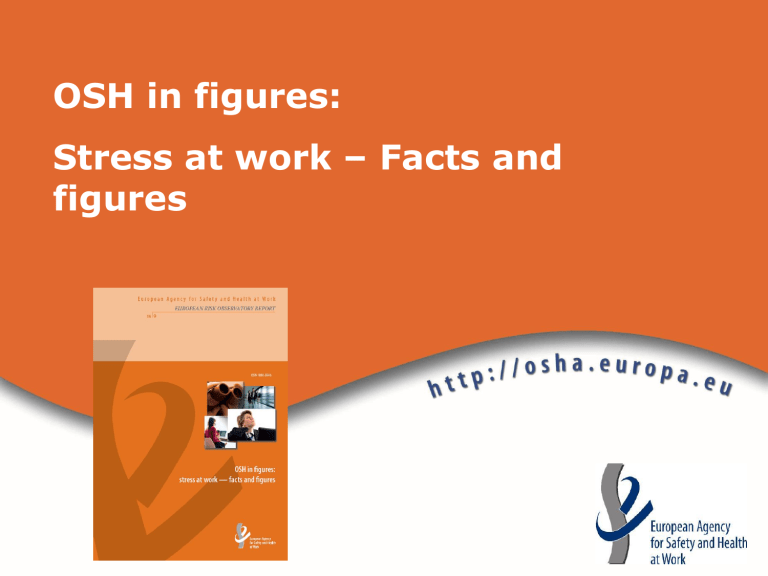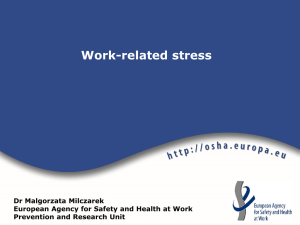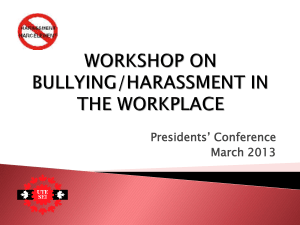English - European Agency for Safety and Health at Work
advertisement

OSH in figures: Stress at work – Facts and figures Stress – facts and figures Introduction Stress is the second most frequentlyreported work-related health problem, affecting 22% of workers from the EU 27 (in 2005) Studies suggest that stress is a factor in between 50% and 60% of all lost working days. This represents a huge cost in terms of both human distress and impaired economic performance The number of people suffering from stressrelated conditions caused or made worse by work is likely to increase due to the changing world of work which is making increased demands on workers Stress – facts and figures Introduction “Work-related stress is experienced when the demands of the work environment exceed the workers’ ability to cope with (or control) them” If the stress response continues over a longer period, or if it is particularly intense, this may have serious consequences on health Stress – facts and figures Introduction Symptoms of work-related stress Organisational: o accidents, errors, increased costs from compensation or health care, reduced productivity, absenteeism, high staff turnover, harassment, poor time-keeping and disciplinary problems. Symptoms of work-related stress Physiological: back problems, weakened immunity, peptic ulcers, heart problems, hypertension. o Cognitive: difficulty in concentrating, remembering, learning new things, making decisions o Emotional: irritability, anxiety, sleep problems, depression, hypochondria, alienation, burnout, relationship problems o Behavioural: abuse of drugs, alcohol, and tobacco o Stress – facts and figures Prevalence Work affects health (% yes)* In 2005, the level of reported stress was lower in EU15 than in EU10 or in two Acceding Countries (Bulgaria and Romania) 40 30.4 30.9 30 20 20.2 EU-15 NMS-10 AC-2 15.9 10.3 10 0 11.5 11 11.9 7.6 stress irritability sleeping problems 7.9 7.2 8.9 anxiety *European Foundation for the Improvement of Living and Working Conditions. Fourth European Working Conditions Survey, 2005. Stress – facts and figures Prevalence The level of reported stress in EU countries* 60 The highest levels of stress were reported in Greece (55%), and in Slovenia (38%), Sweden (38%), and Latvia (37%), whereas the lowest levels were registered in United Kingdom (12%), Germany, Ireland, and the Netherlands (16%) as well as in the Czech Republic (17%), France 55 50 40 38 37 33 32 30 27 20 35 31 27 26 28 22 21 18 16 28 25 21 17 35 31 27 21 38 18 16 16 12 10 and Bulgaria (18%). *European Foundation for the Improvement of Living and Working Conditions. Fourth European Working Conditions Survey, 2005. EU27 NL BG RO UK FI SV SK SI PT PL AT MT HU LT LU LV IT CY IE ES FR EL EE DE DK BE CZ 0 Stress – facts and figures Prevalence The level of reported physical violence and harassment (bullying) at work in EU-27 (% yes)* 8 6 6 5.1 4.3 4 1.8 2 0 threats of physic al violenc e physic al physic al harassment violenc e from violenc e from (bullying) c olleagues other people 1.8 unwanted sexual attention *European Foundation for the Improvement of Living and Working Conditions. Fourth European Working Conditions Survey, 2005. Stress – facts and figures Prevalence Change in tempo of work during last 12 months (2002) * Tempo at one’s workplace has: Finland % Lithuania % Latvia % Estonia % considerably increased 18 11 13 11 somewhat increased 30 34 31 31 remained the same 48 43 47 48 somewhat decreased 3 8 6 5 considerably decreased 0 1 1 1 do not know 1 3 2 4 N=1297 N=909 N=904 N=900 Number of respondents *The Working Life Barometer in the Baltic Countries , 2002. Stress – facts and figures Prevalence Health problems among workers reporting job insecurity (Spain, 2007)* 40 Health problems such as e.g. tiredness or headaches are significantly more frequent among people who feel job insecurity I may lose job during 6 m.- agree 35 I may lose job during 6 m - disagree 30 25 Stress prevalence 18.6 20 16.8 16 15 11.8 13 11.6 9.7 10 11.9 8.3 6.3 7.6 3.7 5 0 Difficulties in falling asleep or sleeping badly Feeling of constant tiredness Headaches *VI Encuesta Nacional de Condiciones de Trabajo, 2007 Sickness Difficulties in Difficulties in concentrating remembering and and forgetting maintaining things easily attention Stress – facts and figures Prevalence The Netherlands: the most prevalent cause of becoming work disabled is psychological or mental disorder* *The Netherlands Center for Occupational Diseases Stress – facts and figures Stress by age European workers (%) reporting stress, overall fatigue, sleeping problems, anxiety, and irritability by age (2005)* -24 The highest stress level is observed among middle aged workers, and the lowest among older and younger workers. 25-39 40-54 55+ % 30 24.3 23.2 22 19.1 17.9 20 23.4 14.3 13.1 8.2 10 9.9 7.9 7.7 3.5 11 9.4 7.1 12.1 8.5 5.5 3 0 stress overall fatigue sleeping problems anxiety irritability *European Foundation for the Improvement of Living and Working Conditions. Fourth European Working Conditions Survey, 2005. Stress – facts and figures Stress by age Among the workers who consulted a doctor because of stress, the majority belonged to the 35-44 and 2534 age groups. Percentage Percentage of workers who consult a doctor because of stress at work by age (Spain, 2003)* 45.00 40.00 35.00 30.00 25.00 20.00 15.00 10.00 5.00 0.00 18-24 25-34 *V Encuesta Nacional de Condiciones de Trabajo, 2003 35-44 45-54 55-64 ≥65 Stress – facts and figures Stress by gender European workers (%) reporting stress, overall fatigue, sleeping problems, anxiety, and irritability by gender (2005)* Men reported work-related stress more frequently than women (23% and 20% respectively), however this difference is not very big male female % 30 23 22.9 20.3 20 19.1 11.2 8.5 10 8 7.7 7.9 9.6 0 stress overall fatigue sleeping problems anxiety irritability *European Foundation for the Improvement of Living and Working Conditions. Fourth European Working Conditions Survey, 2005. Stress – facts and figures Stress by gender Perceived increase of mental stress at work (considerable or somewhat) by gender (2002)* 34 Finland Women reported higher increase of mental stress at work (during last 12 months) 43 44 Lithuania 52 men w omen 34 Estonia 42 36 Latvia % 42 0 10 20 *The Working Life Barometer in the Baltic Countries , 2002. 30 40 50 60 Stress – facts and figures Stress by gender Workers reporting work stress by gender (Belgium, 2004)* Women have problems with stress at work slightly more often than men. The percentages of men and women for whom stress at work is an acute problem do not differ significantly 80 72.4 69.8 70 60 50 % 40 30 Non-problematic 30.2 26.7 Acutely problematic 10 20 10.6 10 0 *Flemish Workability Monitor, 2004 Male Problematic Female Stress – facts and figures Stress by gender Physical violence, bullying/harassment and unwanted sexual attention by gender (2005), EU-25?* Prevalence of reported physical violence is similar among women and men. Women, especially young women, are more at risk of harassment/bullying and unwanted sexual attention than men. Men Women % 8 6 6.3 6.2 6 4.7 4.1 4.3 4 3 1.7 2 2.1 0.8 0 T hreat of physical violence Physical violence from colleagues Physical violence Bullying/harassment from other people Unwanted sexual attention *European Foundation for the Improvement of Living and Working Conditions. Fourth European Working Conditions Survey, 2005. Stress – facts and figures Stress by sector Prevalence of stress, anxiety and irritability by sector (2005), EU-27?* In 2005 stress was the most prevalent in the education and health sectors, as well as in agriculture, hunting, foresty & fishing (28.5%). Education and health Public administration and defence Real estate Financial intermediation Transport and communication Stress Hotels and restaurants Anxiety Irritability Wholesale and retail trade Construction Electricity, gas and water supply Manufacture and mining Agriculture 0 5 10 15 20 25 30 *European Foundation for the Improvement of Living and Working Conditions. Fourth European Working Conditions Survey, 2005. Stress – facts and figures Stress by sector Ranking of stress indicators in educational sector according to teacher unions (2007)* Ranking of stress indicators Average score 1. Burnout / depression / emotional exhaustion 3.62 2. High absenteeism / sickness 2.60 3. Sleeping problems / insomnia 2.51 4. Cardiovascular diseases / symptoms 2.50 5. Frequent interpersonal conflicts 2.42 6. Migraines 2.39 7. Hypertension / high blood pressure 2.34 8. Gastrointestinal disorders 2.08 9. High staff turnover 1.67 10. Addictions (drinking, smoking, drugs) 1.48 *European Trade Union Committee for Education (ETUCE), 2007. Stress – facts and figures Stress by sector Physical violence by sector, EU-27?* Threat of phy sical v iolence Education and health and public administration and defence are the sectors most affected by physical violence Phy sical v iolence from other people 5 Education and health 8.4 3.5 Public admnistration and defence 0.5 Real estate 1.7 1.7 Transport and communication 8.8 0.7 Whole sale and retail trade 7.2 Construction Electricity , gas and water supply 1.1 1.3 1.2 1.4 1.8 0 7.4 4.5 1.9 1.9 Manufacture and mining 11.6 3.1 1.3 Hotels and restaurants 14.6 1.4 2.2 0 Financial intermediation Phy sical v iolence from colleagues 9.8 9.3 5.4 3.8 4.5 10 *European Foundation for the Improvement of Living and Working Conditions. Fourth European Working Conditions Survey, 2005. 20 % Stress – facts and figures Stress by sector Bullying/harassment and unwanted sexual attention by sector* Bullying / harassment Unwanted sexual attention Hotels and restaurants, education and health and transport and communication sectors most affected by bullying /harassment 2.7 Education and health Public admnistration and defence 1.3 Real estate 1.3 5.3 3.1 1.9 Financial intermediation 7.8 2.4 2.6 Transport and communication 6.9 3.9 Hotels and restaurants 1.8 Whole sale and retail trade 0.8 Construction 6.1 2.9 0.5 Electricity, gas and water supply 5.9 1.4 Manufacture and mining 8.6 4.1 0 *European Foundation for the Improvement of Living and Working Conditions. Fourth European Working Conditions Survey, 2005. 10 % Stress – facts and figures Stress by occupation Prevalence of work-related stress in different occupations (Poland, 1997- 2000)* "Stress refers to a situation in which a person feels tense, restless, nervous, or anxious, or is unable to sleep at night because the mind is troubled all the time. Do you feel that kind of stress these days?" Teachers, middle medical staff, government and local government administration clerks, and bank workers reported highest level of stress Bank workers 29.6 Middle medical staff 30.6 18.1 Construction workers Salesmen 24.8 Government and local government administration clerks 30.2 21.2 IT specialists Public transport drivers 22.9 Teachers 34 26.6 All occupations 0 10 *Central Institute for Labour Protection – National Research Institute, 2000 20 30 40% Stress – facts and figures Stress by occupation Percent of workers reporting work-related stress by occupation (Belgium, 2004)* Senior management/directors Senior managers / directors and middle managers /professionals reported highest level of stress Middlemanagers/professionals Educational or care functions Problematic Acutely problematic Non-management w hitecollar w orkers Skilled blue-collar w orkers and technicians Unskilled/experienced blue-collar w orkers % 0 *Flemish Workability Monitor, 2004 10 20 30 40 Stress – facts and figures Stress by sector Occupational diseases by sector (the Netherlands, 2005)* Financial institutions Psychological diseases are the most prevalent in education, financial institution and health care Reparation and trade Transport Psychological diseases Musculoskeletal diseases Education Hearing diseases Skin diseases Construction Health care Manufacturing industry % 0 20 40 *The Netherlands Center for Occupational Diseases, 2005 60 80 100 Stress – facts and figures Stress by employment status European workers reporting stress and stress-related health problems by employment status (self-employed and employee) (2005), EU-27?* Self-employed Well-being scores for selfemployed workers are lower than for employed workers employee % 30 27.3 24.9 21.3 20.2 20 17.3 14.3 9.4 10 8.1 9 11.210.4 7.6 3.3 1.8 0 stress overall fatigue sleeping problems anxiety irritability headaches heart diseases *European Foundation for the Improvement of Living and Working Conditions. Fourth European Working Conditions Survey, 2005. Stress – facts and figures Stress by employment status Lack of control at work reported by workers on permanent and temporary contracts (Spain, 2007)* 100 90 Workers on temporary contracts have lower control over their work compared to workers on permanent contracts Permanent Temporary 80 70 60 50 40 30 36.5 35.1 24.4 19.5 22.2 36.8 24.5 35.7 23.7 36.9 24.3 20 11.2 10 0 Terms of holidays Employing ow n ideas Order of tasks *VI Encuesta Nacional de Condiciones de Trabajo, 2007 Methods of w ork Rhythm of w ork Breaks Stress – facts and figures Costs of stress In 2002, the European Commission reported that the yearly cost of work-related stress in the EU15 was EUR 20.000 million each year France: the cost to society of occupational stress is somewhere between EUR 830 and EUR 1.656 million, the equivalent of between 10% and 20% of all expenditure by the Occupational Accident and Disease branch of the social security system The Netherlands: most of the costs to society of poor working conditions come from work-related absence and disability, which are mainly caused by musculoskeletal disorders (43% of the all diagnoses) and psychological diseases (40%). UK: In 2005/6 work related stress, depression and anxiety cost Great Britain in excess of £530 million. Stress – facts and figures Emerging risks The main emerging psychosocial risks identified in the forecasts*: New forms of employment contracts and job insecurity (the use of more precarious contracts together with the trend towards lean production and outsourcing) The OSH risks for the ageing workforce Work intensification - high workload and work pressure High emotional demands at work, violence and harassment Poor work-life balance Combined exposure to psychosocial and physical risks All of these risks affect workers’ health and safety. They may increase work-related stress and lead to serious deterioration of mental and physical health. *EU-OSHA – European Agency for Safety and Health at Work, 2005-2007 Stress – facts and figures More information available at: Agency’s information on stress: http://osha.europa.eu/en/topics/stress Publication: http://osha.europa.eu/en/publications/reports/TE-81-08-478-ENC_OSH_in_figures_stress_at_work/view European Risk Observatory: http://riskobservatory.osha.europa.eu European Agency for Safety and Health at Work: http://osha.europa.eu/ Thank you for your attention!








